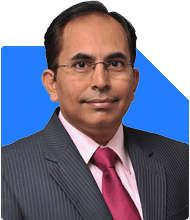43-Year-Old Retiree with ₹2.46 Crore Portfolio: Will It Last 40 Years?
Janak Patel |72 Answers |Ask -Follow
MF, PF Expert - Answered on Mar 26, 2025
He is the CEO and founder of InfiniumWealth, a firm that specialises in designing goal-specific financial plans tailored to help clients achieve their life goals.
Janak holds an MBA degree in finance from the Welingkar Institute of Management Development and Research, Mumbai, and has over 15 years of experience in the field of personal finance. ... more

Hello Sir, I am 43 year old guy with own house in metro and no liabilities/loan. My current retirement portfolio consists of Equity MF 1.75 Cr, Debt MF 35 Lakhs, PF & Gratuity 36 Lakhs (Total: 2.46 Cr) . I will reach 3 Cr in next 2 years and I plan to retire by then. I also have a plot worth 30 lakhs I will rebalance my portfolio to have 50% Equity and 50% Debt/Fixed Income. If my monthly expense is 60,000 with no dependents, will my portfolio last for 40 years with 7% inflation and 8% returns?
You have decided to retire early and you have already accumulated 2.46 Cr + assets without any outstanding liabilities. Congratulations on your achievements.
Retiring early is on many peoples wish-list and you too have the same desire. So lets see how you are placed for early retirement.
Expecting to have a corpus of 3 Cr in the next couple of years and you have planned a rebalancing of the portfolio too. So with the inflation rate of 7% and return rate of 8% as acceptable, lets see what to expect in the future after 40 years.
Short answer - After 40 years you will have a corpus of over 10 Cr remaining after expenses are taken care of.
This is primarily because your withdrawal/expenses are much below the growth/returns on the portfolio and hence each year the value of your portfolio in increasing.
Lets me clarify that this is not considering any tax liabilities you will need to service on the withdrawals each year. The tax liabilities will depend on the composition of your portfolio and your strategy of withdrawal amounts from Equity and debt/fixed income buckets.
But I am sure even after considering tax liabilities, your corpus will be sufficient and at the end of 40 years you will still have a considerable amount to pass on as inheritance to your loved ones/charity (though you mentioned no dependents).
I would like to recommend you have good Health cover (outside of your employer) and buy it asap. Also retirement of 40 years is a long time and hence do give some thought on how you plan to occupy your time. I hope you have a plan of what you will do once retired. Engage yourself in meaningful and fulfilling activities and keep minimum idle time - exercises, sports, reading, cooking, meeting/catching up with friends and family etc. This will help you stay healthy in mind and body. As money is not your concern, you don't need to think of earning any income from these activities/engagements, so it should be about giving you pleasant experiences. Best time to travel is in early retirement, so go and enjoy.
I also recommend, that you engage/consult with a Certified Financial Planner who will guide you with your retirement corpus planning and other requirements including taxation. Any wrong decision at an early stage can prove very costly and the impact can be felt for long too. Hence it will prudent to get the right advice and guidance at appropriate time.
All the best for long and enjoyable future.
Thanks & Regards
Janak Patel
Certified Financial Planner.
You may like to see similar questions and answers below
Ramalingam Kalirajan |10908 Answers |Ask -Follow
Mutual Funds, Financial Planning Expert - Answered on May 06, 2024
Ramalingam Kalirajan |10908 Answers |Ask -Follow
Mutual Funds, Financial Planning Expert - Answered on Nov 08, 2024
Ramalingam Kalirajan |10908 Answers |Ask -Follow
Mutual Funds, Financial Planning Expert - Answered on Mar 25, 2025
Naveenn Kummar |237 Answers |Ask -Follow
Financial Planner, MF, Insurance Expert - Answered on Sep 17, 2025
Reetika Sharma |432 Answers |Ask -Follow
Financial Planner, MF and Insurance Expert - Answered on Oct 15, 2025
Ramalingam Kalirajan |10908 Answers |Ask -Follow
Mutual Funds, Financial Planning Expert - Answered on Dec 20, 2025
Ramalingam Kalirajan |10908 Answers |Ask -Follow
Mutual Funds, Financial Planning Expert - Answered on Dec 20, 2025
Naveenn Kummar |237 Answers |Ask -Follow
Financial Planner, MF, Insurance Expert - Answered on Dec 20, 2025
Ramalingam Kalirajan |10908 Answers |Ask -Follow
Mutual Funds, Financial Planning Expert - Answered on Dec 19, 2025
Nayagam P P |10859 Answers |Ask -Follow
Career Counsellor - Answered on Dec 19, 2025
Ramalingam Kalirajan |10908 Answers |Ask -Follow
Mutual Funds, Financial Planning Expert - Answered on Dec 19, 2025
Ramalingam Kalirajan |10908 Answers |Ask -Follow
Mutual Funds, Financial Planning Expert - Answered on Dec 19, 2025
Ramalingam Kalirajan |10908 Answers |Ask -Follow
Mutual Funds, Financial Planning Expert - Answered on Dec 19, 2025
Radheshyam Zanwar |6751 Answers |Ask -Follow
MHT-CET, IIT-JEE, NEET-UG Expert - Answered on Dec 19, 2025
Radheshyam Zanwar |6751 Answers |Ask -Follow
MHT-CET, IIT-JEE, NEET-UG Expert - Answered on Dec 19, 2025














.jpg)










